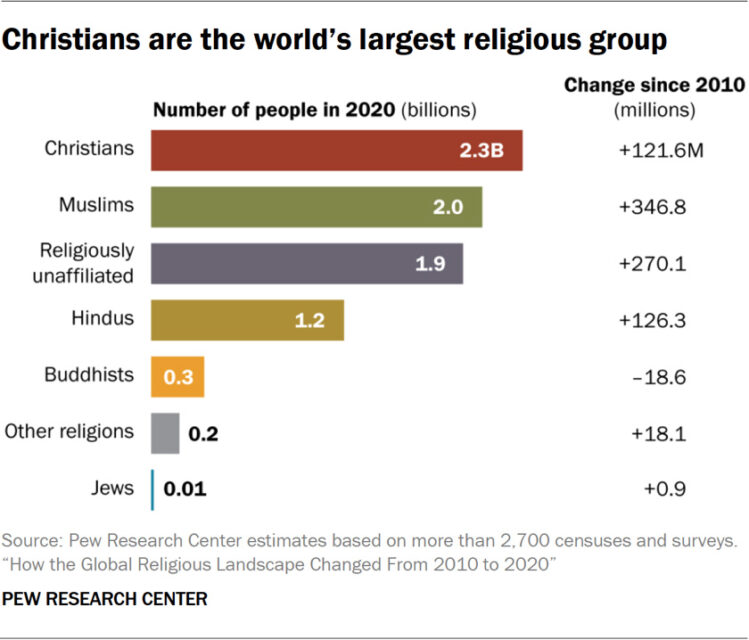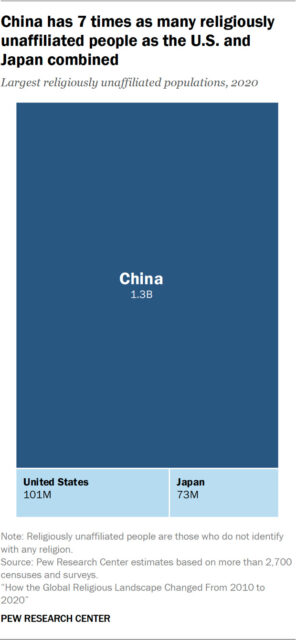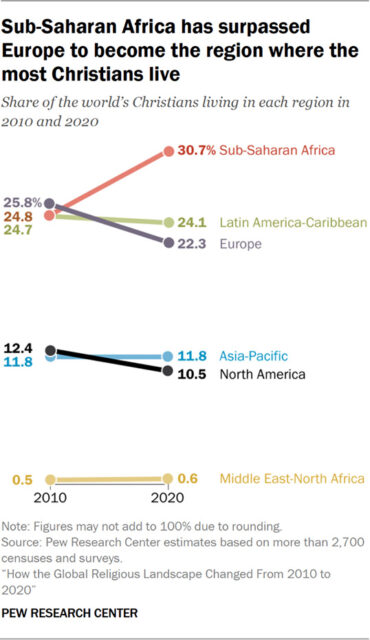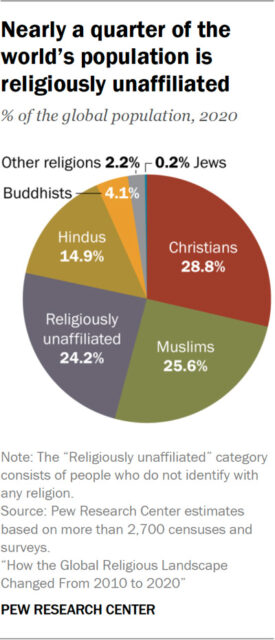(RNS) — A new Pew Research Center study measuring the evolution of the global religious population shows Muslims are the fastest-growing faith group, followed by the religiously unaffiliated. Though it remained the world’s largest religion, the Christian population declined between 2010 and 2020.
Pew’s Global Religious Landscape study, released on Monday (June 9), is the second edition of a demographic report of religious groups, started in 2010.
“We look at the demographic characteristics of these groups, their age structure, how many children they’re having, how much education they have, because these demographic characteristics affect the future size of the religious groups,” Conrad Hackett, a senior demographer at Pew Research Center, told RNS on June 6.
The study focuses on Buddhists, Jews, Hindus, Christians, Muslims and the religiously unaffiliated, also known as nones. It also looks at “others,” which include folk and traditional religions, wiccans, Zoroastrians and more.
The report, which also analyzed those who switched religions, reveals how religious disaffiliation and natural population growth in certain regions influenced the global religious landscape.
The world’s Muslim population increased by 347 million people over 10 years — more than all the other religions combined — primarily due to natural demographic growth.

“Christians are the world’s largest religious group” (Graphic courtesy Pew Research Center)
“Muslims are having children at a greater number than Muslims are dying,” Hackett said. “Very little of the change in Muslim population size is a result of people becoming Muslim as adults or leaving Islam as adults.”
Researchers relied on 2,700 data sources, including national censuses, demographic surveys, population surveys and population registers, to document the religious affiliations of 100,000 people across 201 countries. While questions varied from one survey to another, most participants were asked about the religion with which they identified. The study also analyzed religious data in conjunction with data on fertility and mortality rates and age distribution to measure demographic changes between 2010 and 2020. It also noted delays from the COVID-19 pandemic.
Muslims are largely concentrated in regions with high population growth, like the Middle East-North Africa region, where they represent 94.2% of the population, and sub-Saharan Africa, where they represent 33%. The Muslim population grew the most in the Asia Pacific region, which is home to the largest Muslim population, increasing by 16.2% between 2010 and 2020.
Though Christianity remains the world’s largest religious group, and the number of Christians grew over 10 years, representing 29% of the worldwide population, it declined by 1.8% due to larger population growth among non-Christians. It steadily declined in Europe, North America, the Americas, Australia and New Zealand, Hackett explained.

“Christians made up 29% of the global population in 2020, down from 31% in 2010” (Graphic courtesy Pew Research Center)
Christianity declined by 8.8% in Europe and 10.8% in North America. In the United States, the Christian population fell from 78.3% to 64% over the course of the study.
In France, Uruguay, the United Kingdom and Australia, the Christian population dropped below 50% over the same time period.
In addition to an increase in religious disaffiliation, the decline of Christianity in Europe, which now represents 22.3% of the population, can also be explained by low fertility rates and high death rates. By contrast, Africa, where fertility rates are higher, is now home to the largest Christian population. One-third of the world’s Christians live in sub-Saharan Africa.
Christianity remains the majority faith in all regions except for Asia Pacific and the Middle East-North Africa region and is now the most geographically dispersed religious group, the study shows.
The growth of the global non-Christian population, which increased by 15%, is in part due to the growth of the religiously unaffiliated, also called nones. Religiously unaffiliated are now the third largest group behind Christians and Muslims, with 24% identifying as such globally.
Despite an aging population and a lower fertility rate than other religious groups, nones have grown over the past decade because of religious switching. For every adult raised non-religious who joined a religion, about 3.2 adults left the faith in which they were raised, the study shows.
“This pattern is common in European and North American countries, as well as in Australia and New Zealand, where many people who were raised Christian no longer claim any religious affiliation,” reads the report.
Those leaving religion greatly impacted the proportion of the world’s Christian population. “Christians are seeing a lot of people who are raised in the faith changing as adults to people who don’t identify with any religion,” Hackett said.
The study marks the first time Pew has tracked religious switching patterns, aggregating data from 117 countries of people ages 18 to 54 regarding the faith they were born into and the religion they identify with as adults.
In North America, the religiously unaffiliated population increased by 13 percentage points between 2010 and 2020, reaching 30.2%. Nones grew by 4.1 percentage points in Latin America-Caribbean over the same period, and by 6.6 percentage points in Europe, reaching 25.3%.
Asia Pacific is home to the largest religiously unaffiliated population, with 78.3% of the nones population living in the region. The majority of the world’s nones population, 67%, lives in China. However, Hackett noted the difficulty of capturing the complexity of religiosity in China, on which Pew has conducted research.

“China has 7 times as many religiously unaffiliated people as the U.S. and Japan combined” (Graphic courtesy Pew Research Center)
Buddhists are another group impacted by religious disaffiliation in the East-Asian region, with more people leaving the faith than joining between 2010 and 2020. It is the only religious group that has fewer members in 2020 than in 2010, having declined by 19 million people, according to the data. Buddhists’ slow demographic growth also factors into the decline.
However, the study notes that the Buddhist population estimates don’t fully capture the influence of the faith, as many Buddhist respondents may not identify as Buddhist even though they engage in Buddhist practices.
Hindus, representing 14.9% of the world’s population, are the fourth largest group in the world. The majority of Hindus live in India (95%). And between 2010 and 2020, the number of Hindus increased by 62% in the Middle East-North Africa region, mostly due to migration. In North America, the Hindu population increased by 55%.
The world’s Jewish population, the smallest religious group analyzed in the report, grew by 6% between 2010 and 2020, from about 14 million to 15 million people. Jews represent 0.2% of the global population, which remained stagnant over 10 years, and 45.9% of Jews live in Israel — the highest percentage in any country.
In the U.S., Pew estimates Jews represent about 2% of the population, which includes people who identify as religious Jews but also atheists and agnostics who consider themselves culturally Jewish or by heritage.
Migration also impacted the size of religious groups in certain regions. In the Gulf countries (Bahrain, Kuwait, Oman, Qatar, Saudi Arabia and the United Arab Emirates), which have the world’s largest share of foreign-born residents, migration contributed to the growth of non-Muslims, mostly Hindus and Christians.
The Global Religious Landscape study is part of the Pew-Templeton Global project, a program funded by the Pew Charitable Trust and the John Templeton Foundation to study changes in religious practices and religion’s influence on the world through surveys, demographic studies and reports on religious restrictions.









